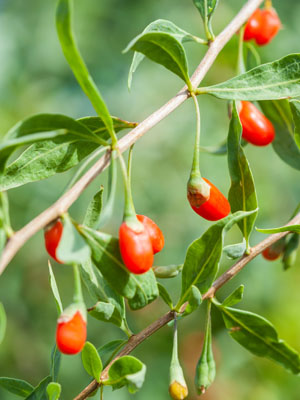Crop Rotation Group
Solanaceae (Potato and tomato family)
|

|
Soil
Moist, well-drained soil enriched with plenty of compost.
|
Position
Full sun to part shade. Goji berries can be used in wildlife hedges, or a single clump can be grown as a large, arching shrub.
|
Frost tolerant
Established plants are winter hardy at least to -10°F (-23°C). Goji berry grows best where summers are hot and winters are mild.
|
Feeding
None needed, but young plants require steady moisture to become established.
|
Companions
-
|
Spacing
Single Plants: 6' 6" (2.00m) each way (minimum)
Rows: 6' 6" (2.00m) with 6' 6" (2.00m) row gap (minimum)
|
Sow and Plant
Start seeds indoors in late winter, and grow under bright supplemental light. Set out hardened-off seedlings or a purchased plant in spring at about the time of your last frost. Water regularly to keep the roots from drying out.
Our Garden Planning Tool can produce a personalized calendar of when to sow, plant and harvest for your area.
|
Notes
Native to China, Goji berry is considered invasive in parts the US. Plants have very vigorous roots that spread aggressively into nearby soil. The berries are high in antioxidants, and often are considered a superfood.
|
Harvesting
Pick goji berries when they turn a deep red color and pull away freely with a gentle tug. Gently wash and dry berries to be used in teas. Or, cook the seedy berries into a juice for making syrup. Fruits left on the plant will be harvested by animals and birds in early autumn.
|
Troubleshooting
Goji berries are subject to winter injury, but new plants can be grown from surviving buds taken from near the base of the plants. Prune plants more than two years old to remove old wood and control the height of the plants. Cutting back growing tips in spring encourages the plants to produce heavy-bearing lateral branches.
|